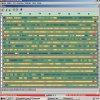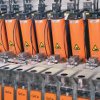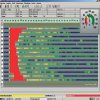Answers to bond quality
1 March 2004German company GreCon says that often questions like “What is bond quality?and “Is there a correlation between bond quality and internal bond?are asked.
While appreciating that a wood based panel manufacturer does not want to sell bond quality as such, but panels of an adequate quality, GreCon claims that its UPU 3000 helps to achieve that goal by monitoring the bond quality in the panels as they are produced.
As a specialist in on-the-line measuring technology for wood based panels, GreCon has already offered earlier generations of the Ultrasonic Camera UPU 3000 and blow detection systems UPU 919 and UPU 2000.
The target of the new UPU 3000 was to reveal hidden optimisation potential and offer more than a simple blow detection system.
Thus the company says that with the new UPU 3000, the range between a simple blister/ no blister, or good/bad, statement is broken down. Now the question it is designed to answer is “how good?or “how bad?”
However, GreCon suggests that the real question is what these statements actually refer to. It is not the panel quality as such, because, due to physics, some important quality parameters such as internal bond and expansion cannot be determined online – at least not yet.
But GreCon says that the ultrasound measuring method does allow the measurement of other features. The number and size of glue bridges as well as their degree of hardening, for example, have an important effect on both the panel quality and the ultrasound signal.
The higher the number of glue bridges and the bigger their extent, the better the ultrasound signal can penetrate the panel – and vice versa. A similar behaviour applies to the hardening of the glue: the harder the glue, the easier the ultrasound can penetrate the panel.
To describe these correlations, the term ‘bond quality’ was chosen.
This behaviour was already used for blow-detection systems, but their configurations were not able to resolve and display the processes within the panel. The information from these systems may be considered digital – a ‘good/bad’ statement on quality control.
Automatic calibration and dirt accumulation control are used to ensure consistent and reliable measuring results, despite high temperatures and high amounts of dust in the measuring position, says GreCon.
The bond quality is graphically represented by the system, with a true resolution of up to 250 values in their allocated colours.
Due to its varied configuration possibilities, the UPU 3000 can be adapted to different panel parameters and, importantly, tothe customer’s requirements. It has a high a resolution and can display the full range of a ‘too good’ and an ‘extremely bad’ bond quality.
GreCon says a clear and simple representation of the bond quality and its trend is shown by a quality indicator. All measured data is compressed in a graph, which indicates the quality on a scale, similar to a speedometer.
The UPU 3000 can detect blisters and automatically sort out panels, like its predecessor, the UPU 2000 system, but it is also said to be a reliable aid to optimising the production process and increasing productivity.
Changes in the bond quality caused, for example, by changes in the press factor, panel moisture, share of glue, or the glue quality are immediately shown by a change in colour.
The UPU 3000 can be used for changes in the process, such as prolongation of the press or change from wet to dry gluing. Due to the continuous monitoring of the panel bond quality, the time required for start-up is reduced and GreCon says that a pay-off time of only six months is possible.


